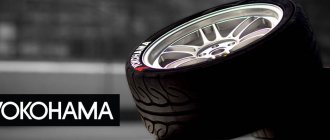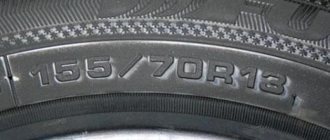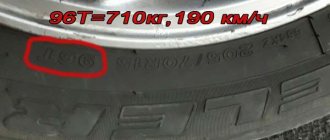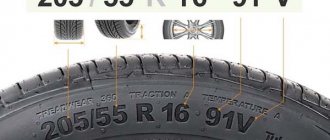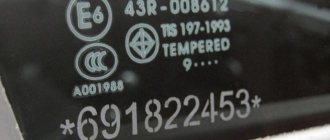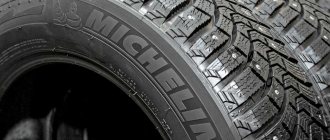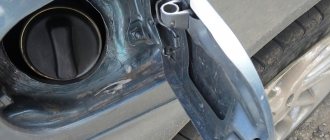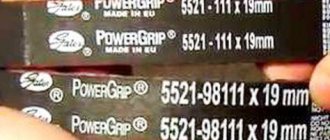A lot depends on the right choice of shoes for your car. When deciding to purchase a kit, you can be guided by various comparative tests. However, it is worth remembering that their characteristics must correspond to operating conditions. In this case, the information indicated in the markings on the sidewall of the tire will help. Such inscriptions on the tire indicate the size of the product and its technological characteristics. Below we will decipher the symbols and try to figure out what the numbers and letters in the rubber markings mean.
Where to indicate the standard size and its interpretation
Tire markings have mandatory and optional designations.
So, on each tire the manufacturing company, the brand of the rubber itself and the tire size will be indicated. The three-digit designation on tires indicates the wheel size in inches, tire width and profile height. The numbers are located on the outside. We have a wheel with parameters, for example, 195 60 R16. This means that we have tires in front of us with a tread width of 195 mm. The second number is the ratio of the picture's height to its width. The higher this parameter, the more “grippy” the tire will be. This value is usually called the profile indicator. The third number is the tire's inner diameter in inches. In general, a common mistake is that motorists purchase wheels without paying attention to some data on changes in external parameters. For example, size 185 65 r15 will differ in height from 210 65 r15 with the same bore diameter. The ratio of the profile to the width in our case may interfere with the installation of tires on the car. This factor should be understood and taken into account. A special calculator will help you correctly calculate tire sizes.
Please explain the difference between 175/65 and 185/60 tires. What do these numbers mean?
If it’s winter in the city, then you need to take the same width as summer ones - for a car weighing a ton, you shouldn’t take 185, if you don’t drive on asphalt, take the narrowest ones - it’s better on snow, but traction on asphalt is a nightmare...
175 is the profile width in millimeters, and 65 is the height in %% relative to the width.
175 and 185 are the width in millimeters and 65 and 60 are the height in percentages, which means the height is relatively the same and 185 is 1 cm wider.
There is no difference whether it is winter or summer, it is height and width. Depends on the car model. The size supplied at the factory is preferable.
175 width 65 height tires in winter, narrower tires are preferable
narrower is better for the winter. you can visually estimate here - tires.spb.ru/index.php?mid=11 the first one will be 3 mm higher, with a radius of 14 Discs are suitable for both options
touch.otvet.mail.ru
Speed indices
Also, tire manufacturers are required to provide all tires with a speed index. This sign can be found immediately after the wheel size indicator. It talks about the maximum speed you can travel on the roads. A table that deciphers the speed index of passenger car tires will help you read this sign correctly.
| Tire classification by speed | |||||||||
| Designation | N | P | Q | R | S | T | U | H | V |
| Speed | 140 | 150 | 160 | 170 | 180 | 190 | 200 | 210 | 240 |
Load indices
Immediately after the speed index on the car tires there is an index of the permissible load on each wheel. For example, the tire marking contains the indicator 88t. This indicates that the car can travel at a maximum speed of 190 km/h, and the maximum permissible load on each wheel is 560 kg.
On certain tires you can find designations in the form of the letters XL or the word Reinforced. This marking is usually awarded to tires whose load index is higher than standard values. If the number 88 is written on the sidewall of an xl or extra load tire, then add 3 to the value. deciphering this figure costs 91 or 615 kg per wheel.
| Digital designation | load in kg one wheel for passenger cars |
| 60-70 | 250-335 |
| 71-80 | 345-450 |
| 81-90 | 462-600 |
| 91-100 | 615-800 |
| 101-110 | 825-1060 |
| 111-120 | 1090-1400 |
| 121-129 | 1450-1850 |
Compliance
Tires produced in the CIS countries and Russia in particular have inscriptions indicating that they comply with state standards or certain technical conditions. On the sidewall they are applied with the document code, for example: GOST 4754-97 or TU2521-036-00148984-98. In addition, tires certified in Russia are sometimes marked with the PCT mark, which indicates the presence of a certificate.
Tires intended for the European market are embossed with a sign of compliance with UNECE rules N30. The number in the circle is the country code, and the one outside is the designation of the standard, for example E4 0220984.
Tires produced for the North American market are marked DOT (Department of Transportation USA), which consists of an alphanumeric code that encrypts the manufacturer, the size of the slope, and the manufacturing plant, for example, DOT M746 JR1R.
Decoding of the American standard size designation
American tire manufacturers resort to different tire markings. The first one is very similar to the European one, only before the dimension there are additional letters P - passenger, LT - light truck or T - truck. For example, 185 r14c P means that this is a wheel with a tread width of 185 mm, a diameter of 14 inches and intended for passenger cars.
The second system for classifying its products has a completely different look. If the European system measures the dimensions of car tires in millimeters, then the American system measures the dimensions of car tires in inches. However, it is quite simple to understand. For example, there are numbers on tires 27*11*r15. The first number is the outer diameter of the tire, the second is the tread width, and the last number is the inner diameter.
I have 185/60/R14 tires, will there be any difference if I install 185/65/R14? Thanks in advance.
65 is the width. It is possible that in extreme positions the steering wheel will catch on the body.
The profile height will be 5% higher
a little higher, depending on the car
high profile tire and low profile tire. what are their differences? in your case the changes are almost invisible. It will be a little softer though. The tires may wear out at the edges, as you need to choose how much to increase the tire pressure.
Find a TIRE CALCULATOR on the Internet, enter the old size and the new one, it will show you the difference. 185/65 is the ratio of tire height to width.
the speedometer will lie) and 65 is not the width, but the height!
Cross-country ability and comfort on rough roads will increase. 185/65 has a higher load index (86 versus 82), that is, the tire is initially stronger. Due to the stronger sidewall, such breakdowns as on 175/65 do not occur. Well, there is a difference in price - 185/65 is more expensive, their price is close to R15. Due to the larger diameter, the speedometer readings will change, usually it begins to show a more believable speed. The resource 185/65 is also slightly higher. If we compare these two sizes, then 185/65 is preferable. The 60th profile is neither for us nor for you - there is no controllability yet (it also breaks down when cornering), but there is no comfort anymore. The 55 holds better, but it also shakes noticeably.
A centimeter of height will be added, the width will be the same
touch.otvet.mail.ru
Color-coded tire markings
To facilitate the installation of wheels on rims, manufacturers sometimes equip them with additional color marks that carry their own information. How to decipher such icons is below.
Yellow tire markings
Sometimes you can see a yellow dot or triangle on tires, which means the lightest place on the tire. When mounting, it is necessary to align the mark with the heaviest part of the disk to facilitate balancing.
Red rubber markings
Additional tire parameters include the red circle or triangle symbols that can be found on the sidewall of the rubber. This is the designation of the hardest point of the tire wall. It must be combined with o on the disk.
White stamp with a number
A white stamp with a number located on the outer side carries information about the inspector who carried out the final “acceptance” of the goods.
Color stripes
Some tires have radial colored stripes. They help identify tires of certain brands in the store and quickly search for them in the warehouse. Sometimes the color of the strip indicates the date of manufacture or the country of manufacture, and also indicates that it has been run-in.
Manufacturer and model information
In addition to the size, the brand name and model are printed on the side to identify the tires, for example: Nokian Hakka Green, Michelin Energy, Toyo Proxes, Good year Ultra Grip, Belshina BEL-347, Amtel NordMaster, Hankook K415 Optimo and others.
The inscription “ Made in... ” indicates the country of manufacture (Russia (Russia), Germany (Germany), USA (USA), France (France), China (China), etc.).
The year and week of manufacture on the tires are marked in a rounded oval with four numbers: for example, “0915” would mean that the tire was made in the 9th week of 2015.
Additional inscriptions on the sidewall of the tire
On many passenger tires, in addition to the model designation and tread type, there is additional marking:
- the letter R indicates that the tires are of a radial design - older models are designated by other letters;
- the presence of the word steel in the design means the presence of steel cord;
- An E in a circle indicates compliance with European ece requirements;
- Aqua – tires with improved behavior on wet asphalt and in aquatred aquacontact rain conditions;
- TL (TubeLess) - tubeless tire; in the absence of this marking, a tube is required;
- Outside – the outside of the installation. Differs from the inner sides with an asymmetric tread. It will help you figure out which side should be on the outside when installing a set of tires on a car;
- DOT - compliance with the safety requirements of standardization countries;
- Rotation - applied to sets with a directional pattern. The wheels should rotate in the direction indicated by the arrow;
- Treadwear is an indicator of wear resistance. Many tires have wear markings in the form of grooves. An increased number of layers is indicated by the letter C;
- RF (RunFlat) - rubber with reinforced cord. Capable of traveling more than 80 km at the lowest pressure - 0 atmospheres. There are cases when both punctured wheels held the road well at speeds of up to 80 km/h.
Seasonality
It's also worth understanding what the seasonal badges on wheels mean.
- Winter – designation of winter tires. It has a soft rubber composition, and some tires are equipped with 1.6 mm high studs, which provide better traction on icy roads;
- M+S badges are found on many winter and summer kits. This marking stands for Mud+Snow. The tires have a pronounced pattern and are able to perform well in bad weather conditions. However, universal tires behave worse than profile sets.
Date of manufacture
Next to the wheel size there are four more numbers indicating the date of manufacture of the set. It's quite easy to read if you understand the calendar. The first two digits are the serial number of the week, and the second are the year of production. That is, number 4215 indicates that the kit was produced in the 42nd week of 2015.
Summer
If in winter the driving conditions are very varied, then in summer there is no such problem and the choice is easier to make. First of all, you should remember that using winter tires in summer is not only damage to public roads, but also an unreasonable waste of your own funds. Winter tires are softer, more elastic, and in the summer they wear out quickly, and are more expensive than summer tires.
Excellent modern tires, carefully designed to maintain handling and stability at high speeds - Nexen Classe Premiere. All sizes, including 186/65R15, feature an optimized tread pattern. It reduces movement resistance and increases traction, which ultimately allows you to save fuel and effectively use the vehicle's capabilities.
For wet roads, many drivers of B-class cars recommend the elastic Continental ContiEcoContact 5 tires. This model of tires in size 185/65R15 has low noise levels with excellent grip, excellent handling and excellent braking. When using these tires, rolling is characterized by a low level of resistance, which is achieved due to the improved composition of the rubber mixture. The only drawback of the unique design is the high price.
With a wide range of choices, 185/65R15 tires remain one of the most popular models. Thanks to their versatility and optimal performance, they are well suited to almost any operating conditions. The design features of tires from various manufacturers allow you to enhance their advantages and choose a product to suit your needs.
